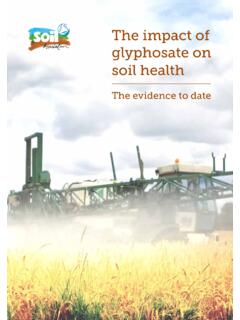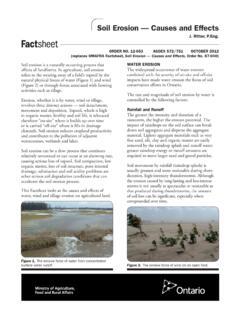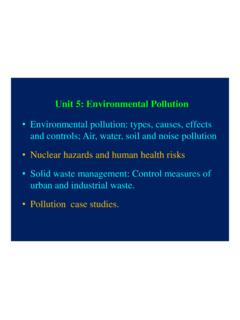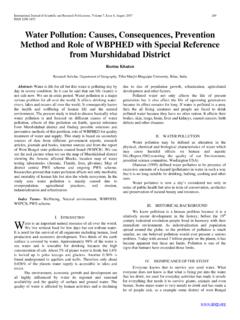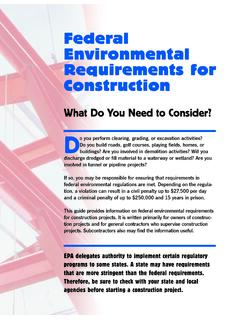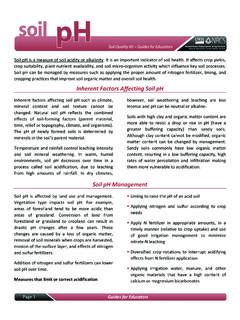Transcription of Remediation Techniques for Soil and Groundwater
1 POINT SOURCES OF POLLUTION: LOCAL EFFECTS AND IT S CONTROL Vol. II - Remediation Techniques for soil and Groundwater - Zhang Encyclopedia of Life Support Systems (EOLSS) Remediation Techniques FOR soil AND Groundwater Zhang Department of Environmental Science & Engineering, Tsinghua University, Beijing, China Keywords: Remediation , soil , Groundwater , aquifer, contamination, hazardous materials, volatile organic chemicals, degradation, transformation, containment, pump and treat, air stripping, soil vapor extraction, solidification, soils washing, vitrification, desorption, bioremediation, China Contents 1. Introduction 2. Containment 3. Pump-and-Treat 4. soil Vapor Extraction 5. Solidification/Stabilization 6. soil Washing 7. Bioremediation 8. Air Stripping 9. Precipitation 10. Vitrification 11. Thermal Desorption 12. Strategy for Technique Selections 13. Future Development Glossary Bibliography Biographical Sketch Summary Rapid development of China in social and economic areas has created an environment of serious contamination of soils and Groundwater .
2 Major contamination sources from industry, agriculture and urban areas have not been put under strict control. The accumulation, mobilization and toxicity of various contaminants in soils and Groundwater are threatening the natural environment as well as the sustainable development of China. Remediation is the only way to clean up the contaminants in soils and Groundwater . General technical methodologies include transfer of contaminants solely by themselves, with contaminated soils, or Groundwater to other places for final treatment or disposal; confinement of contaminants in place; and destruction of contaminants in place. Mechanistic principles are physical, chemical and biological processes. Remediation Techniques which have been commonly used include: containment, pump-and-treat, extraction, stabilization/solidification, soil washing, air stripping, precipitation, vitrification, thermal desorption and biological Remediation .
3 Among the Remediation Techniques currently in use, physicochemical processes can POINT SOURCES OF POLLUTION: LOCAL EFFECTS AND IT S CONTROL Vol. II - Remediation Techniques for soil and Groundwater - Zhang Encyclopedia of Life Support Systems (EOLSS) quickly remove contaminants from soils and Groundwater but usually considerable energy consumption are required. Biological processes can save energy but often it takes longer time to reach desired Remediation level. Remediation Techniques with low cost and high efficiency are being developed in China. 1. Introduction The contamination of soils and Groundwater is becoming a serious problem in China since the contamination sources have not been controlled in an effective manner. These major sources are from industrial activities, agricultural practices and consumption actions. Every year, there are about 600 million tons of solid wastes produced as a result of industrial production and resident consumption, which is still increasing at a rate of 10% per year.
4 It is estimated that more than 64% of the entire Groundwater has been contaminated in urban areas. Agricultural activity also accounts for a major pollution source. About million ton/year plastics is left in soils after being consumed, 25% of the total nitrogen fertilizer is released to Groundwater through permeation or runoff, a significant portion of pesticides applied is not functional and left in soil . In addition, industrialization in the rural areas poses an ever increasing threat to soil and Groundwater . For a quite long period of time, the town and village enterprises in rural areas will be operated with less not up-to-date technologies and unskillful management practice will soon be vanished before they can fully developed or be eliminated through market competition. Currently about 280 million tons of solid wastes are discharged in the countryside every year by those town and village enterprises.
5 The presence of contaminants in soils and Groundwater at concentrations above background levels demonstrates a high potential health and ecological risk. Common contaminants include a variety of volatile hydrocarbons-such as benzene, toluene, ethylene, and xylene (BTEX compounds)-found in fuels; heavy paraffins and chlorinated organic compounds including polychlorinated biphenyls (PCB); inorganic compounds lead, chromium, cadmium, arsenic and mercury; and radionuclides such as tritium. Often, soil is contaminated with a mixture of contaminants. The nature of soil , the contaminant s chemical and physical characteristics , and environmental factors as climate and hydrology interact determine the accumulation, mobility, toxicity, and overall significance of the contaminant in any specific instance. Remediation Techniques play a key role in fully cleaning up the contaminants in soils and Groundwater . Remediation refers to the process of environmental cleanup of contaminated sites and the Techniques to reduce or eliminate contamination from soil or Groundwater .
6 Remediation pathways include transfer of contaminants alone, or with contaminated soils or Groundwater to other place for final treatment or disposal, confinement, and destruction of contaminants in place. Technical principles for Remediation can be divided into physical, chemical and biological processes. Techniques frequently used are: containment, pump-and-treat, extraction, stabilization/solidification, soil washing, air stripping, precipitation, vitrification, thermal desorption, and bioremediation. POINT SOURCES OF POLLUTION: LOCAL EFFECTS AND IT S CONTROL Vol. II - Remediation Techniques for soil and Groundwater - Zhang Encyclopedia of Life Support Systems (EOLSS) 2. Containment Containment is a common technique adapted to contain contaminated ground waters or soils within a site; or to divert ground or surface waters away from that contaminated site, for the purpose of limiting their contact with people, the ecosystem on the sites, and minimizing the potential for further contamination to happen.
7 The objective of containment is achieved by the construction of low-permeability or impermeable cutoff walls. Most of the walls are built with soil , bentonite, and water mixture; walls of such composition provide a barrier with low permeability and chemical resistance at low cost. Other wall compositions of cement, bentonite, and water may be necessary if additional structural strength is required or if chemical incompatibilities between the bentonite and site contaminants exist. The desired permeability of the completed wall is typically 1 10-3 cm/sec to 1 10-6 cm/sec. Wall construction is often performed in a continuous manner with the simultaneous processes of trench excavation, support slurry fill, backfill mixing, and backfill emplacement. Slurry walls are typically placed at depth less than 50 m and are often to m in thickness. There is a substantial cost increase for walls deeper than 30 m.
8 Depending on the site conditions and contaminants, the trench can be either excavated to a level below the water table to capture chemical floaters or extended into a lower confining layer. Similarly, on the horizontal plane, the slurry wall can be constructed around the entire perimeter of the contaminated site or sections thereof. soil -bentonite walls are the most popular and less costly. Attapulgite may also be used in cases where the bentonite is not compatible with the waste. A newer development in technology is the use of fly ash as a high carbon additive not only to lower the permeability of the soil -bentonite but also to increase the adsorption capacity of the soil -bentonite with respect to the transport of organic chemicals. Recent advances have extended to include the use of microfine cement, mineral wax, sodium silicates and colloidal silica gel. Montan wax is a fossilized plant wax with properties similar to that of natural plant waxes.
9 Soils or slurry walls permeated with these agents show a significant reduction in permeability. Composite slurry walls incorporate an additional barrier, a geomembrane, within the trench to improve impermeability and chemical resistance. The geomembranes often are plastic screens which are comprised of high-density polyethylene pile plank sections. The membrane is easy to install, having a long life; and is resistant to animal and vegetation intrusion, microorganisms, and decay. Combining the membrane with a bentonite slurry wall may be the most effective combination. It is usually effective to construct the bentonite-cement slurry wall and then install the membrane in the middle of the wall. Slurry walls have the potential to provide an effective, long-term, low-cost, and low-maintenance solution to the control of contaminant migration in soil and Groundwater . Such walls are typically quick to be constructed and can provide for a fast-response solution to an acute Groundwater contamination problem.
10 However, the slurry walls along do not eliminate the source of the contamination or reduce its toxicity, and additional Techniques are required to permanently eliminate or reduce the threat of POINT SOURCES OF POLLUTION: LOCAL EFFECTS AND IT S CONTROL Vol. II - Remediation Techniques for soil and Groundwater - Zhang Encyclopedia of Life Support Systems (EOLSS) contamination. 3. Pump-and-Treat Pump-and-Treat is a primary technique for Groundwater and soil Remediation . In this process, Groundwater is pumped to the surface, and contaminants are removed by a variety of treatment methods, including air-stripping, activated carbon, ultraviolet or ozone treatment, precipitation and biodegradation. This technique is accomplished through one or more pumping wells, with the water being treated by any one of physical and biological methods or their combinations. Pump and treat systems are relatively easy to design, install and operate using standard hydro-geologic and engineering practices.










